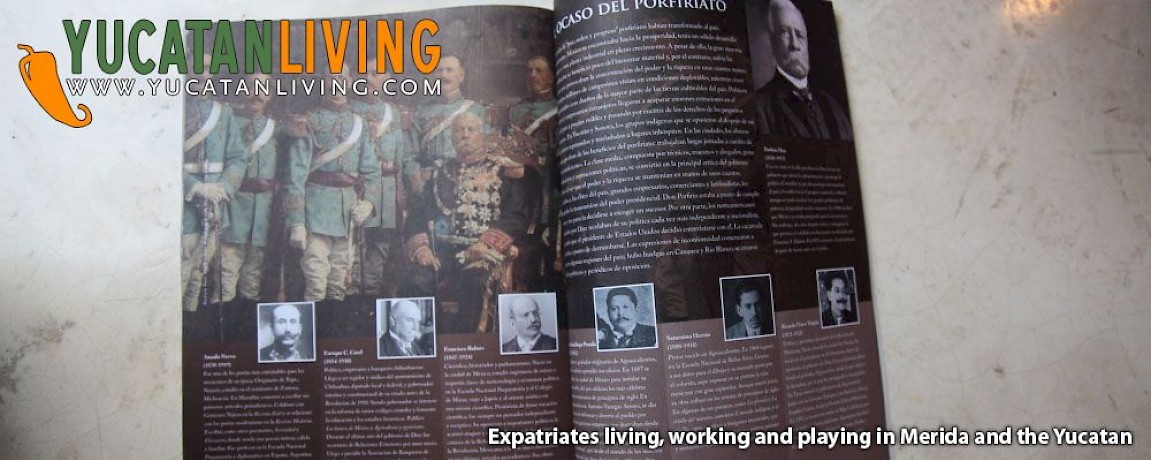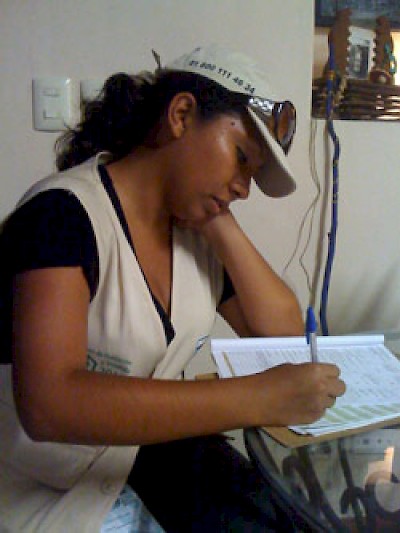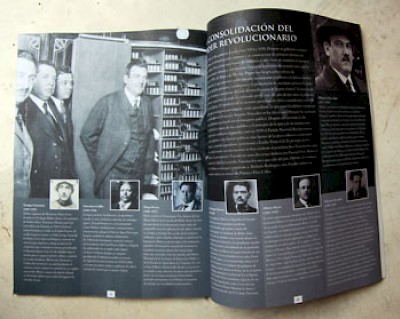2010 Census and Mexican History Book
We have been contacted in a personal way by the Mexican government twice in the last two days. Both events were unexpected, delightful and worthy of comment.
2010 Mexico Census
First of all, our doorbell rang and we found a young lady with a clipboard at our front door. As the ambient temperature at the front door was about 108 degrees Fahrenheit, we invited her inside without a moment's thought. She was dressed in a uniform, with the INEGI logo on her hat and her shirt. Very neat, very business-like. What is INEGI? Instituto Nacional de Estadística y Geografía. The National Institute of Statistics and Geography. Besides making some pretty awesome maps of Mexico, INEGI is also in charge of the national census, and that, as it turns out, is why this young lady was at our door.
Lately, the Working Gringos have been feeling like they have been in Merida for a very long time (8 out of the 12 years that they have been married, for example). Being interviewed for the census reminded us that we were actually here for the last census (five years ago) as well!
Yucatan Statistics from 2005
The young lady handed us a brochure to look at while she was getting ready to ask us questions, and the brochure had some statistics from the last census taken in 2005. Among other things, it said that Yucatan was the 21st state in the nation by population, with a population at that time of 1, 818, 948 citizens, representing 1.8% of the population of Mexico. The growth of the population was demonstrated in a graph, which showed a pretty dramatic increase in the last twenty years. In 1900, Yucatan only represented .3% of the population, and as late as 1970, only .8%.
The population of Yucatan was then broken down by age. 57% of the population in our state is under the age of 30, a majority of them women (922,386 women compared to 896,562 men). The most populous city is Merida, of course, with 781,146 inhabitants in 2005. Tizimin and Valladolid are about the same size (69,553 and 68,863 respectively), with Uman and Kanasin (both suburbs of Merida) next in line. We always tell people that Merida is a city of a million people... and we're wondering if by 2010, we'll actually be right.
In 2005, according to the brochure, 93% of the population of Yucatan had running water in their home, 96% had electricity, 90% had a television (82.9% in 2000), 72% had a refrigerator and only 16% had a computer. That may not sound like a lot, but that number was 7% in 2000. In 2000, 52% of homes in Merida had a washing machine, and that grew to 65% in 2005. These alone should be interesting statistics to compare when the next census results are released.
In 2005, the brochure tells us that 33% of Yucatecans over the age of 5 years spoke an indigenous language. 527,107 people told INEGI that they spoke Maya, 618 spoke Chol, 355 spoke Tzeltal and 260 spoke Zapotec languages. This sounds impressive to us, but not when we found out that this number was 11,177 fewer indigenous speakers than in the year 2000.
A pair of pie charts demonstrated that in 1930, 52% of the population was Rural and 42% Urban. In 2005, 17% was Rural and 83% Urban. Wow. The average number of people in a home was 4.4 in 2000, and that decreased to 4.1 in the year 2005.
We looked on the INEGI website to see if we could find out more. We read that in 2005, 2.1 % of the residents of Yucatan had arrived from somewhere else within the last five years (including us!). In the census right before that, in 2000, that percentage was 3%, so the influx of visitors had actually decreased. We also learned that in the year 2000, 8.9% of the population had a college degree (or more). In 2005, that percentage increased to 11.6%.
The young lady in her INEGI uniform was ready to go, and proceeded to ask us questions and fill out her form. How many people lived here? What are our ages? Years of schooling? How many rooms? Did we have bathrooms? Did we have a television? She didn't ask if we had computers... she could see at least three of them from where she sat. She did ask what nationality we were, so we're hoping there is a line item for that result in the next census report.
She finished in about four minutes and then packed up to go. Before she left, she plastered a sticker on our door, indicating that we had been counted. All very efficient, all very professional. We have been counted! And we look forward to the results!
Mexican History Book in Our Mailbox
As if that wasn't enough, the very next day, we opened our mailbox and found a magazine, with a cover letter from President Felipe Calderon. The magazine is really a soft-cover book, entitled Viaje Por La Historia de México (Travel Through the Story of Mexico). The book, he explains, is a gift from the Mexican government in this very important year that is both the Centennial celebration of the Revolución and the Bicentennial celebration of the Independencia de México. For these reasons, he says, this is Año de La Patria (Mexican Heritage Year).
The letter goes on to say that the Independence and the Revolution are the two biggest and most important events in the history of Mexico, and for this reason, "we ought to celebrate with happiness and pride the privilege of being Mexicans... proud to belong to our country, and proud of our culture, our history, our roots and our traditions. We ought to celebrate with jubilation our glorious past and, at the same time, Mexican Heritage Year is an opportunity to think about and start constructing the future that we want for our nation".
For all these reasons, Calderon decided that each Mexican home should have this book, a brief and simple history written by the historian, writer and gran mexicano, Luis González y González.
In closing, he hopes that this year will mark "the beginning of a new age of development with justice, liberty and democracy for Mexico". Hear, hear.
We love the book, really. It begins the history of Mexico with its Mesoamerican past, from the Olemecs through the classical native american empires, establishing these as the roots of Mexican identity. After the conquest, most of the book is a profile of historic individuals, and we wonder how they chose who to include. Diego Rivera is there, but Frida is not. Emiliano Zapata and Francisco Villa are there, of course, but the two most important revolutionary figures in Yucatan, Salvador Alvarado and Felipe Carrillo Puerto, are not, both of whom are painted in murals in the Governor's Palace here in Merida... and on the facade of our house, by the way. Still, it's a very lovely gift from our adopted country, and we are grateful for it.
Thinking of the Yucatan
As we power down our computers at the end of the day today, we will think fondly of the other 96% of the Yucatecans who will be reading this book in their homes tonight, half of whom will be doing so while listening to the sound of their refrigerators and washing machines. Viva, Mexico! y gracias, como siempre.
*****
INEGI's website (in Spanish)
Mexico's Bicentennial website (also in Spanish)











Comments
Bruno 14 years ago
Re: Tiara's question; Afro-Mexicans.
During WWll, I attended High School in Mexico City and many students
last names (born in Mexico)were; Spanish,German, Japanese, Chinese, Arabs, Jewish and English. But none of us or the school's teachers refered to them as: Hyphenated Mexicans.
And I'll never call myself Spanish-Mexican.
JUST MEXICAN.
Reply
Tiara 15 years ago
Was there a separate category on the 2010 census for Afro-Mexicans?
Reply
Viviana Hinojosa 16 years ago
Doing some research, I found that the book Viaje por la historia de México, will be distributed by Servicio Postal Mexicano, that means by mail. So we will have to wait until it arrives at our doors. According to INEGI there are 27 millions homes in this country, that is the amount of books to be delivered. Give them time, is a monumental effort, and we know that things some times can be a little bit slow. I want my copy too.
Reply
Barry 16 years ago
Sadly we have not yet been approached to be counted. Even worse we have not yet received our copy of "Viaje Por La Historia de México." Do you know of a place where we can go to get a copy?
Reply
Barbara Bode 16 years ago
A couple of days ago, I too was interviewed, given a carefully placed sticker and a brochure from a similarly business-like young man. Hot as it was outdoors, it didn't occur to me to invite him in because my foyer was even hotter...information thanks to an indoor/outdoor thermometer left by my home's former owners. Because I'd been working in the garden, I'm sure I looked grubby. From the look of it, could be he thought I didn't have one because I was not asked about a washing machine. I must admit, I only glanced at the brochure. Now I'm going to get it and read it more carefully. Haven't gotten the history book but thanks for the alert. I want to track down a copy.
Reply
Sharron McGrath 16 years ago
I lived in Merida for one month in 2009, three months in 2010 and plan on five to six months in 2011 as the city keeps growing on me. I am most interested in obtaining a copy of the above-mentioned Mexican history magazine/book. Does anybody know where I can get one.
Reply
Working Gringos 16 years ago
Thanks for the insight, Viviana (in case y'all don't know, Viviana is one of our very talented local artists...). CasiYucateco and others, the brochure is called "Yucatán", predictably. We have an instinct that INEGI publishes something like this for every state. It lists the INEGI address on the back: Calle 62#307 in the Centro. Probably, there are more there.
As for the book, we haven't a clue. Did anyone else get it? Or was it just for us?
Reply
Viviana Hinojosa 16 years ago
Great article! Diego Rivera is included, while Khalo is not because by the time Rivera was painting murals in México, Khalo was practically unknown and young. She was not part of Muralismo, o Escuela Mexicana de Pintura. La Escuela mexicana de pintura was a movement financed by the Plutarco Elias Calles goverment (1929) and his secretary of education, Jose Vasconcelos in an attemp to bring arts and culture to the masses, to celebrate everything mexican, and to celebrate the Revolución. That is why Rivera, Siqueiros y Orozco are always mentioned as part of Muralismo, while Khalo is not. She was not part of it. Her recognition came later, and she never painted murals. The murals where painted in the public buildings for their intention was to be art that everybody could enjoy. Arte para el pueblo.
Reply
CasiYucateco 16 years ago
Yes, this sounds very interesting!
Can extra copies of the brochure be picked up at INEGI? Or elsewhere?
And what about the history magazine/book?
I wonder for the houses with owners reported to be out of town, if the census people asked the neighbors. In the USA, they often ask neighbors about some basic information and keep trying to find someone for the empty house(s).
And we're very happy to hear that so many Yucatecans still speak an indigenous language. In all our modernization, there is still much to learn from old languages, references and ways.
Reply
Richard Rhoda 16 years ago
Great article. Unfortunately, when were counted in Ajijic, Jalisco, we did not receive a brochure on ur fine state. But I have been all over the INEGI site in recent years and continue to use it for fascinating data.
Richard
Reply
Peter de la Cour 16 years ago
Fascinating statistics. Very useful information for anyone interested in our adopted city and state. My wife and I have also been counted, but sadly our INEGI rep didn't shows us, let alone leave us, a copy of the useful brochure you mention. Please tell me what it's called and I'll go and get one. As it happens, INEGI is only 2 blocks from our house.
Reply
(0 to 11 comments)Next »